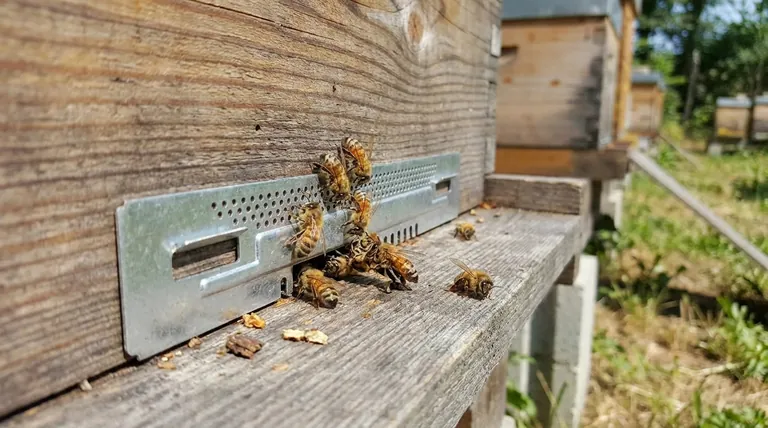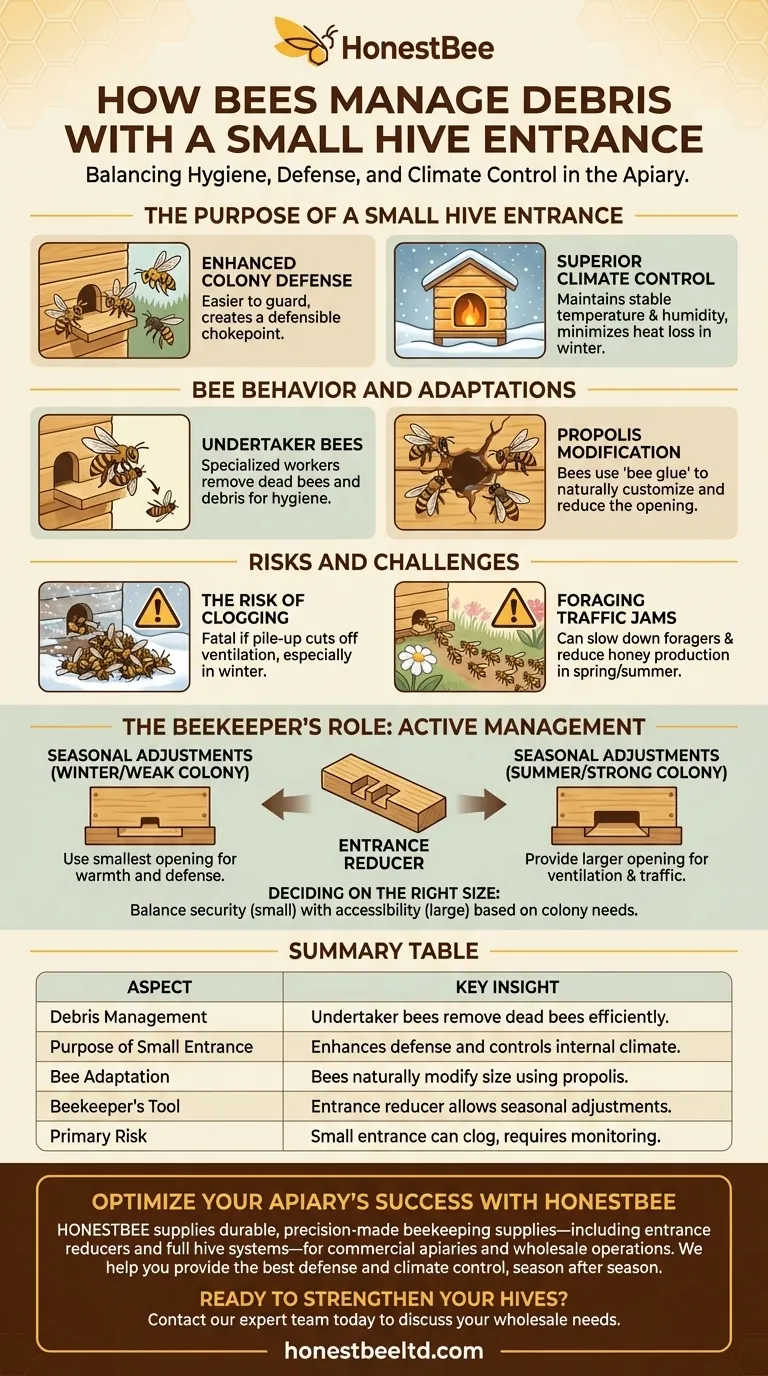In short, yes. Honey bees are remarkably efficient at managing their hives and can remove debris, such as dead bees, even through a very small opening. This is a specific behavior carried out by designated "undertaker" bees who carry the dead out and away from the hive to maintain colony hygiene.
The core principle is that a small hive entrance is a deliberate, strategic choice—made by either the bees themselves or the beekeeper—to prioritize defense and climate control over ease of access. Debris management is a challenge they are well-equipped to handle, but it comes with risks that require monitoring.

The Purpose of a Small Hive Entrance
Understanding why a hive might have a small entrance is key. It's not an oversight; it's a feature that serves critical functions for the colony's survival.
Enhanced Colony Defense
A smaller entrance is significantly easier to guard. It creates a defensible chokepoint, allowing fewer guard bees to effectively repel robbers, wasps, and other intruders who seek to steal honey or harm the colony.
Superior Climate Control
A reduced opening helps the colony maintain stable temperature and humidity inside the hive. This is especially crucial during the cold winter months, as it minimizes heat loss and reduces the energy the bees must expend to keep the cluster warm.
Bee Behavior and Hive Management
Bees have evolved specific behaviors to manage their living space, including the entrance.
The Role of 'Undertaker' Bees
A subset of worker bees specializes in hygienic tasks. These undertaker bees are responsible for locating, lifting, and carrying dead bees or other debris out of the hive and dropping them a safe distance away.
Natural Modification with Propolis
Bees possess the innate ability to modify their hive entrance using propolis, a resinous mixture they produce from tree buds. They use this "bee glue" to seal cracks and reduce the size of large openings, naturally customizing their entrance for optimal defense and insulation, especially when preparing for winter.
Understanding the Trade-offs and Risks
While beneficial, a small entrance is not without its potential downsides.
The Risk of Clogging
The most significant risk is a blockage. A pile-up of dead bees, especially during a cold snap in winter when the colony is less active, can clog a small entrance. This can be fatal, as it prevents cleansing flights and cuts off ventilation.
Foraging Traffic Jams
During a strong nectar flow in spring and summer, a small entrance can become a bottleneck. It can slow down the traffic of foraging bees entering and exiting the hive, potentially reducing the colony's overall efficiency and honey production.
The Beekeeper's Role: Active Management
For beekeepers, managing the hive entrance is a crucial, season-dependent task.
Using an Entrance Reducer
Beekeepers intentionally control entrance size with a tool called an entrance reducer. This is a small block of wood with different-sized notches that can be placed in the hive opening. It allows a beekeeper to give a colony the appropriate-sized entrance for its strength and the time of year.
Making Seasonal Adjustments
A common practice is to use the smallest opening for a new or weak colony and during the winter. As the colony grows and foraging activity peaks in the summer, the beekeeper can provide a much larger entrance to improve ventilation and prevent traffic jams.
Deciding on the Right Entrance Size
Choosing the correct entrance size involves balancing the colony's immediate needs with the seasonal environment.
- If your primary focus is protecting a new or weak colony: Use a small entrance to make defense manageable.
- If your primary focus is maximizing summer honey production: Use a larger entrance to accommodate heavy forager traffic.
- If your primary focus is successful overwintering: Use a reduced entrance for warmth, but ensure it is positioned to prevent blockage from debris.
Ultimately, managing a hive entrance is about providing the colony with the right balance of security and accessibility for its current needs.
Summary Table:
| Aspect | Key Insight |
|---|---|
| Debris Management | Designated 'undertaker' bees remove dead bees and debris efficiently. |
| Purpose of Small Entrance | Enhances colony defense against robbers and helps control internal climate. |
| Bee Adaptation | Bees naturally modify the entrance size using propolis ('bee glue'). |
| Beekeeper's Tool | An entrance reducer allows for seasonal adjustments to the hive opening. |
| Primary Risk | A small entrance can become clogged, especially in winter, requiring monitoring. |
Optimize Your Apiary's Success with the Right Equipment
Managing hive entrances is a critical part of beekeeping. Whether you're protecting a new colony or maximizing honey flow, having the right tools makes all the difference.
HONESTBEE supplies durable, precision-made beekeeping supplies and equipment—including entrance reducers and full hive systems—to commercial apiaries and beekeeping equipment distributors through our wholesale-focused operations. We help you provide the best defense and climate control for your colonies, season after season.
Ready to strengthen your hives? Contact our expert team today to discuss your wholesale needs and discover how our equipment can support your operation's health and productivity.
Visual Guide

Related Products
- Beehive Entrance Reducer Guardian Metal Hive Entrance for Bees
- Multi-Functional Sliding Hive Entrance for Beekeeping
- Multi-Functional Rotary Hive Entrance Disc for Beekeeping
- Professional Reversible Beehive Hive Entrance
- Beehive Entrance Discs Plastic Bee Entrance Disc for Bee Hives
People Also Ask
- What should be done after transferring frames to the new hive? Essential Steps for a Secure Colony
- What size is the entrance hole in a native bee hive? The 13mm Standard for a Thriving Colony
- How can a Langstroth hive entrance be adjusted? Mimic Natural Bee Preferences for a Healthier Hive
- What is the purpose of placing an object in front of the hive entrance after a move? A Guide to Forced Reorientation
- What happens if you seal an entrance to a bee hive? Avoid a Costly Structural Disaster



















